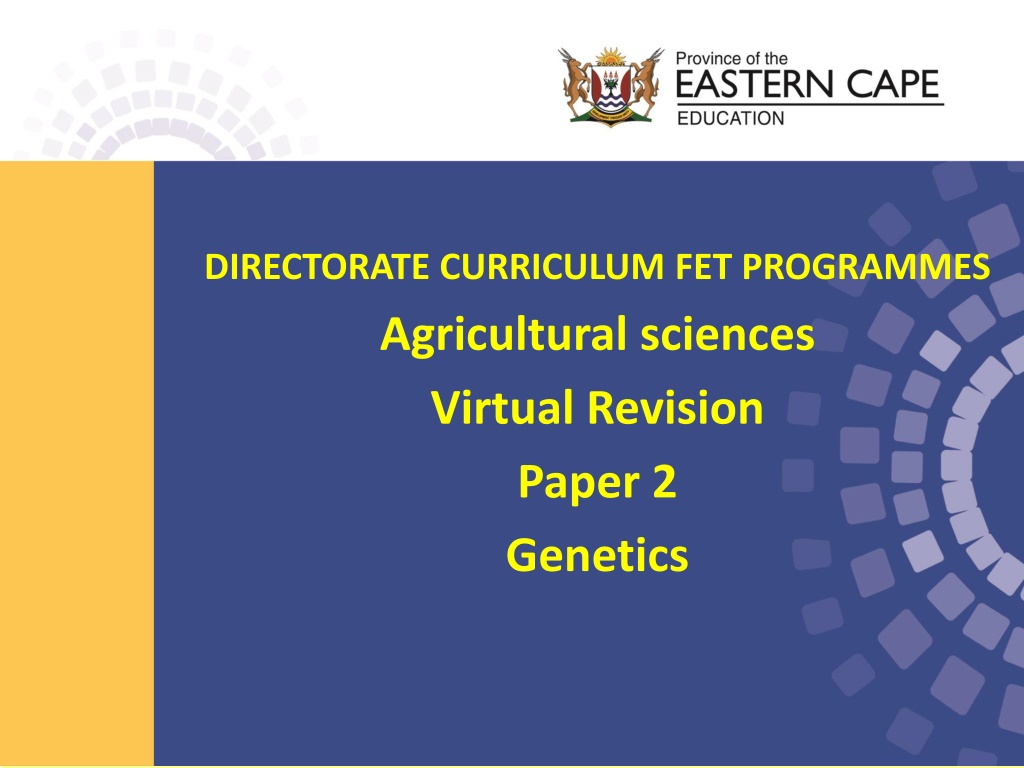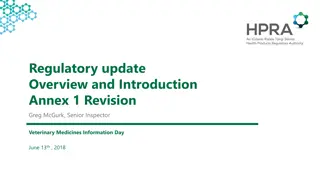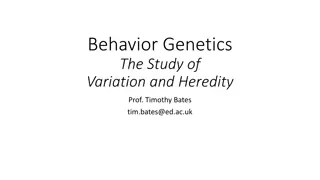Understanding Genetics in Agriculture: Virtual Revision Paper 2
Studying genetics plays a crucial role in agriculture and animal husbandry, aiding farmers in making informed breeding decisions for livestock and plant cultivars. This comprehensive overview covers the basics of genetics, terminology, methods for illustrating crosses, dihybrid crosses, and more, providing essential insights into the transmission of traits and genetic inheritance. Explore the significance of genetics in shaping agricultural practices and enhancing productivity.
Download Presentation

Please find below an Image/Link to download the presentation.
The content on the website is provided AS IS for your information and personal use only. It may not be sold, licensed, or shared on other websites without obtaining consent from the author. Download presentation by click this link. If you encounter any issues during the download, it is possible that the publisher has removed the file from their server.
E N D
Presentation Transcript
DIRECTORATE CURRICULUM FET PROGRAMMES Agricultural sciences Virtual Revision Paper 2 Genetics
What is genetics? Studying genetics is vital in agriculture and animal husbandry because breeding of good livestock and plant cultivars is determined by informed decisions made by farmers when crossing animals, cultivars or breeds. It deals with transmission of traits and the characteristics of genetic chromosomes and genes. material such as
Basic Terminology Homozygous ( BB) Heterozygous ( Bb) Monohybrid inheritance/crosses Dihybrid inheritance/crosses Dominant genes Recessive genes Genotype Phenotype
Methods to illustrate crosses: Genetic diagrams Punnett squares Schematic representations. When we show genetic crosses, we use the following symbols: P1(parental): represents the parent generation F1(1stfilial): represents the first generation of offspring F2(2ndfilial): represents the second generation of offspring, and so on.
Dihybrid crosses A dihybrid cross is between two individuals that have different alleles for two selected traits. A dihybrid cross is used to test for dominant and recessive genes in two separate traits. Mendel used dihybrid crossing to determine if different traits of pea plants, such as flower color and seed shape, were inherited independently. From his experiments, he developed his Second Law: the Law of Independent Assortment or Independent Recombination.
THE CROSS RY Ry rY ry RY RRYY RRYy RrYY RrYy RRYy RRyy RrYy Rryy Ry rY RrYY RrYy rrYY rrYy ry RrYy Rryy rrYy rryy
1. Qualitative characteristic descriptive & subjective measure classification into a few distinct groups examples: hair color; horns/polled; blood types few genes control (often only 1 pair) environment has little if any influence progress not too difficult with 1 gene economic importance
Quantitative characteristics: Many characteristics of economic importance in farm animals fall into this category, example, body size, wool production, milk production, crop yield, disease resistance in plants. This is called polygenic inheritance and is controlled by multiple genes. Examples of quantitative characteristics are weight gain in animals and fat content of meat.
The pattern of inheritance that leads to different phenotypes
Incomplete Dominance Incomplete dominance occurs when heterozygous offspring show a phenotype that is between the phenotypes of homozygous parents. We can say it is a form of intermediate inheritance and a combined phenotype is the result. When we do genetic crosses involving incomplete dominance, we use two different capital letters to represent the genotypes of the parents. One allele is not dominant over the other.
Co-dominance Co-dominance means that both alleles are equally dominant (50%) Both traits are now equally visible in the phenotype of the offspring.
Polygenic inheritance Polygenic inheritance is the inheritance pattern of a characteristic controlled by two or more genes. The genes may be on the same or different chromosomes and each gene may have two or more alleles. Many traits such as colour in wheat kernels, egg weight in poultry and fleece weight in sheep are examples of polygenic inheritance. Organisms with polygenic traits show a range of phenotypes and genotypes for those particular traits.
Epistasis Epistasis occurs when the effects of one gene are modified or changed by one or several other genes. The genes that modify another gene s effect are called modifier genes.
Prepotency Prepotency is the ability of certain animals to transmit their complete set of characteristics to their offspring. Under normal circumstances the offspring inherit one allele from each parent for a specific trait or characteristic. There are exceptional cases where the male parent has the ability to transmit traits or characteristics that laminate the maternal characteristics.
Atavism Atavism is the tendency to revert to ancestral type, evolutionary throwback, traits reappearing which had disappeared generation before. In this case both the spermatozoa and the ovum transmit the recessive characteristic to the zygote, which then possesses a double recessive characteristic.
Variation The differences in the phenotypes of plants or animals of the same species under the influence of the genes and the environment is called variation. An example of variation would be that two calves that are of the same age, breed and are exposed to the same environment, but one is much bigger than the other.
Mutation A mutation is a sudden change in the genetic composition of an organism. A new allele originates, which may be transmitted to the following generations. Mutations could be caused by changes in genes or changes in bigger parts of chromosomes.
Causes of external causes of variation Diseases Climate Light intensity Feeding Topography
Mutagenic agents . Chemical mutagenic agent is nitrite. Nitrite is commonly used as a food preservative that keeps red meat red, and can be present in feeds. Nitrites cause damage to the structure of DNA. Radiation Biological mutagenic agents i.e. viral infection
Changes in chromosome structure Mutagenic agents can cause chromosomes to break, and some may not re-join in the same pattern as before. Chromosomal rearrangements affects the expression of genes and causes changes in the phenotype. New patterns in chromosomal structure
Selection :What is selection? Key principles are heritability and biometrics. Selection is the process of choosing individuals with desirable characteristics to use for breeding in the hope that their offspring will inherit the desirable characteristics. A farmer can improve the characteristics of their herd or crop over a few generations by careful selection and breeding. For example, if a dairy farmer wishes to increase milk production of a dairy operation, the farmer may select the cow that produces the most milk out of the whole herd and use her to breed the next generation of dairy cows.
Principles of selection Heritability Biometrics Heritability refers to the proportion of variation in the population that is due to genetic influences. Heritability increases if genetic variation increases, in which case individuals in a population may show more phenotypic variation. In contrast, heritability decreases if genetic variation is low, in which case individuals in a population may show little phenotypic variation. Biometrics is the analysis of biological data by mathematical or statistical methods. How do we use biometrics to calculate heritability? Look again at the definition of heritability it refers to proportion . Therefore, heritability is a statistical ratio.
Selection methods used by breeders 1 Mass selection 2 Pedigree selection, family selection and progeny selection. A pedigree is records of an individual's ancestors. It contains data about the phenotypic qualities of the ancestors, such as high milk yield or good meat production
Estimated breeding values (EBVs) (EBV) is an estimate of how much better or less than average the offspring will be for a particular characteristic. A breeding value may be either a positive or a negative number. A positive breeding value indicates that the offspring of an individual will be better than average. A negative breeding value indicates that the offspring of an individual will be less than average. The estimated breeding value is a useful tool to help farmers select which individuals to use for breeding. Selecting individuals with high breeding values gives a greater chance of success in a breeding programme.
Types of breeding systems Related breeding 1. Inbreeding 2. Line breeding Outbreeding (Non Related breeding) 1. Cross-breeding 2. Species crossing 3. Upgrading
Genetic engineering or modification Genetic engineering, genetic modification and gene splicing are terms used for purpose of manipulating genes. Outside an organism s normal reproductive process. The concept includes any use of technology to alter the genetic material of a living cell for agricultural, medical or industrial purposes.
Genetic engineering,/genetic modification or genetic manipulation, is human manipulation of an organism s genome using modern DNA technology. It is the process of manipulating the characteristics and functions of the original genes of an organism by introducing foreign DNA (from another species) or synthetic genes into the organism of interest. Genetic modification is a form of biotechnology that produces a genetically modified organism (GMO). The process involves highly advanced scientific techniques and is normally performed in a highly specialised laboratory.
Aims of genetic modification of animals Develop new vaccines and medicines for animals and people. Develop animal models for studies of human and animal diseases Increase the nutritional quality of animal products Increase the health quality of animal products Increase yields of animal products Reduce animal consumption by developing non-animal sources for important oils and industrial enzymes Breed more fertile animals to increase production for the growing world population. .
Current uses of genetically modified plants Pest resistance Disease resistance Herbicide tolerance Nutrition Pharmaceuticals Drought and salinity tolerance Cold tolerance Quality improvements .
The techniques of genetic engineering There are six basic steps in genetic engineering: 1. DNA is extracted from an organism known to have the desired trait, for example resistance to drought. 2. The gene of interest is located and copied. 3. The gene is modified to express in a desired way by altering and replacing gene regions. 4. The gene is delivered into tissue culture cells, using one of several methods, hereafter they are inserted into a chromosome. 5. The new transgenic cells are gown into adult organisms and are checked to make sure they develop normally and are safe. 6. The scientist also checks that the inserted gene appears in the plant s progeny (seeds).
Techniques used to genetically modify plants and animals Recombinant DNA Bacterial carriers Biolistic Calcium phosphate precipitation Electroporation Gene silencing Gene splicing Lipofection Micro-injection Viral carriers.
Some GM crops have a longer shelf life and improved properties such as better flavor, colour, texture and nutritional value. Use of GM crops can have a positive effect on the economy, especially in less-developed countries. Implementation of GM cotton crops has led to economic gains in South Africa. GM crops can allow people to receive medicines and vaccines that are difficult to distribute. By putting vaccines into food products, organizations can more easily transport and administer them to people in need.























